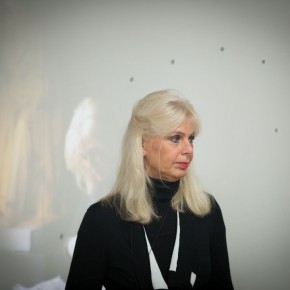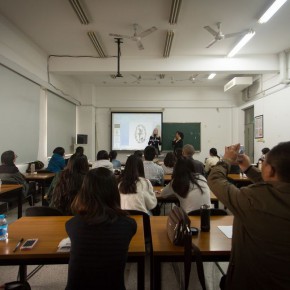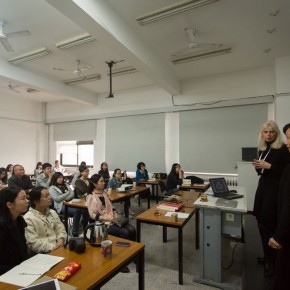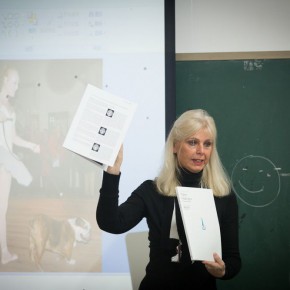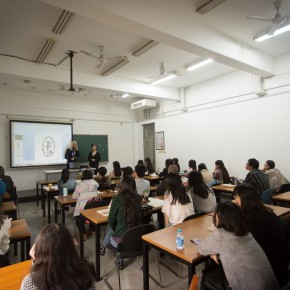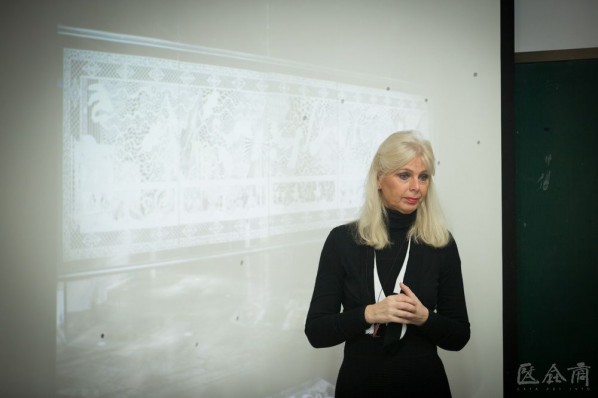
“Paper Dialogue - The Dragon and Our Stories” paper-cut art exhibition is currently held at Today Art Museum, which is an art dialogue about the paper-cut art of “dragon” between Chinese and Western artists, along with Professor Qiao Xiaoguang, from the Department of Cultural Heritage of CAFA, who is a well-known Chinese paper-cut artist and Chinese folk art researcher. Karen Bit Vejle is one of very few recognized paper-cut artists in Europe who creates large, detailed paper cuts at a very high technical and artistic level. On October 9, Qiao Xiaoguang invited Karen Bit Vejle to CAFA to give a speech on her paper-cut creative experience, and it was held at the classroom c203 in building 14, CAFA.
At the beginning of the lecture, Bit told the story of how she learned about paper-cut. In northern Europe, all children together with their parents made paper-cuts as festival decorations at Christmas, so did Bit, she started to make paper-cuts at the age of 5 and was obsessed with it. Bit said that because her father worked in a bank, she often saw the images of the king and queen, but she wasn’t like other children who loved the outlines of the two-dimensional portraits. Bit lovingly said, “All things have their own special contours, regardless whether they are animals, trees, buildings, vehicles or people”. When she was 16 years old, she saw a man making paper-cuts in the sunshine in the old playground at Tivoli in Copenhagen, but he didn’t use the method of cutting a sheet of folded paper that she had learnt in her childhood, instead he was directly cutting paper. Bit recognised that it was a method that changed a paper-cut to an artwork, cutting the world in her mind. Then Bit asked her mother for seamstress scissors, and began to make paper-cuts every day. But Bit was every embarrassed about her paper-cut hobby, although she made paper-cuts every day, she didn’t dare to present them to others, so that she quietly made paper-cuts and then secretly hid them under a carpet.
Bit said that, Hans Christian Andersen played an important role in her paper-cut career. It was often overlooked that Hans Christian Andersen, who was a great writer of fairy tales, was also a paper-cut artist. Affected by Hans Christian Andersen, Bit often made paper-cuts with stories in her mind. It was fortunate that she was invited to use the scissors that Anderson had used to make paper-cuts at the Hans Christian Andersen Museum.
Bit’s paper-cut is not only affected by fairy tales, music is also her inspiration. On the big screen, paper-cuts are inspired by the music of Shostakovich, walking on the white long scroll made by scissors, with a combination of patterns of light and shadow, you could feel the beating of the notes as well as twists and turns of the plots with your eyes, music and paper-cut were blended together. Different from Chinese paper-cuts, Bit’s paper-cuts are often hung, so that people can walk among them, like rambling in the forest.
Following that, Bit told the stories of how paper-cut became her source of income. She cooperated with many big companies, applied the paper-cut patterns on porcelain, blankets, t-shirts, and even became adornments for concerts. But she said she never sold her large-scale works, instead presenting them in exhibitions. In addition, she also created a few small paper-cut works to sell in boutiques. Bit showcased “The Ballet Girl” series of paper-cut work, combining the lithesome body of the ballet dancer with many objects of a metaphor, such as a pug was a symbol of firmness, a dice was a symbol of opportunity, a crown was a symbol of confidence, a knife and fork was a symbol of health, an hourglass was a symbol of time, and so on, combining these stories in paper-cut to bring the girls enlightenment. Bit even invited a real ballet dancer to perform in the exhibition.
At the end of the lecture, Professor Qiao Xiaoguang gifted Bit the book “Art and Life of Chinese Folk Paper-Cut Genius Heirs” containing the Chinese paper-cut art and culture, hoping Chinese paper-cut art spreads to Nordic countries, it is a feeling of freemasonry. Coming from different cultural backgrounds with different mythical images of the dragon, Professor Qiao Xiaoguang and Karen Bit Vejle are both recognized paper-cut artists, so that it is inevitable that wonderful things are created with the cooperation of the “Paper Dialogue”.
Text by Zhang Chi, translated by Chen Peihua and edited by Sue/CAFA ART INFO.
Photo by Quan Jing/CAFA ART INFO.



